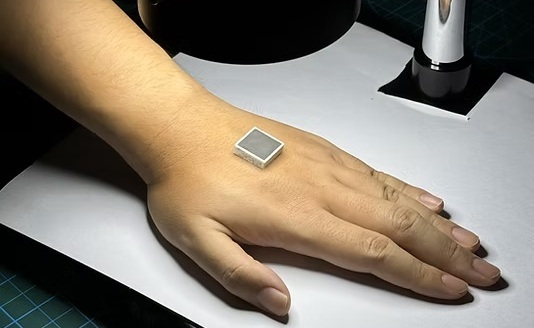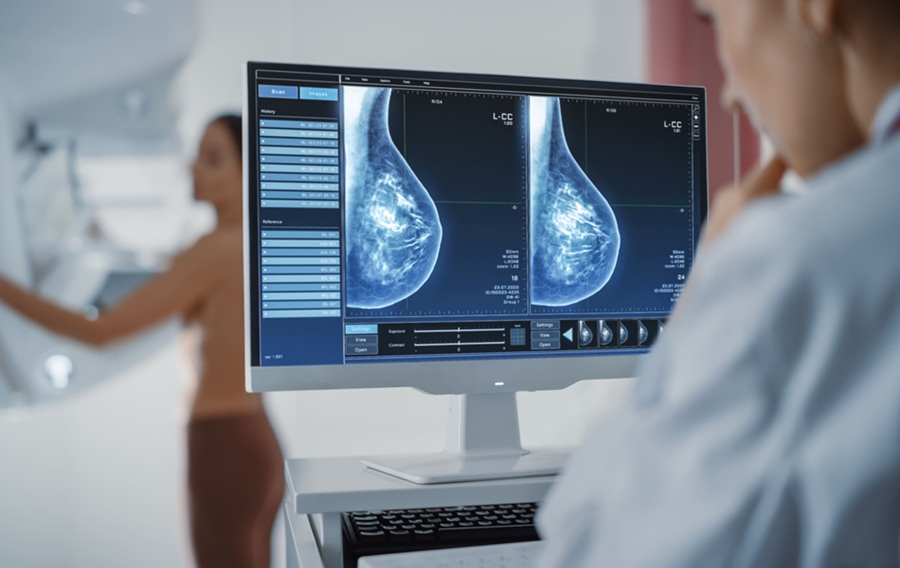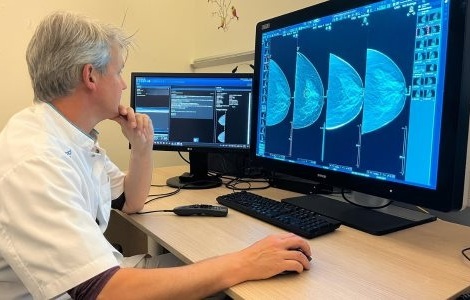FDA Warns Against Thermography Breast Cancer Detection
|
By MedImaging International staff writers Posted on 11 Mar 2019 |
Thermography should not be used as an alternative to mammography for breast cancer screening or diagnosis, warns the US Food and Drug Administration (FDA; Silver Spring, MD, USA).
The FDA safety communication was issued to alert women, health care providers, and those wishing to undergo breast cancer screening that thermography is not an effective alternative to mammography, and should not be used in place of mammography for breast cancer screening or diagnosis. The safety communication followed a warning letter issued on February 22, 2019, to Total Thermal Imaging (La Mesa, CA, USA) for marketing and promoting thermography devices for uses that have not received marketing clearance or approval.
The FDA clarified that thermography devices, also known as digital infrared (IR) imaging devices, have been cleared for marketing only for use with another screening or diagnostic test like mammography, and not for use as a standalone diagnostic tool, and that there is no valid scientific data to demonstrate that thermography devices are an effective screening tool for any medical condition, including the early detection of breast cancer or other diseases and health conditions. Thermography is not a substitute for regular mammograms, and should not be used in place of mammography for breast cancer screening or diagnosis.
The FDA also issued several recommendations for health care providers, including that they educate patients about the limitations of thermography, such as that the high false negative and false positive rates of thermography can provide misleading information that could result in a delayed diagnosis or unnecessary medical follow up. Providers should also discourage the use of thermography to diagnose or screen for breast cancer and talk to patients or caregivers about safe and effective ways to screen for breast cancer, including the benefits and risks of available testing options, clinical breast exams, and other breast imaging options such as ultrasound or MRI, or breast tissue biopsy.
“The FDA is aware that health spas, homeopathic clinics, mobile health units, and other health care facilities are using thermography inappropriately as a standalone tool for breast cancer screening or diagnosis,” stated the FDA. “These types of facilities provide false information that can mislead patients into believing that thermography can find breast cancer years before it would be detected through other methods or thermography improves detection of cancer in dense breasts.”
Thermography refers to digital infrared thermal imaging (DITI), a test that detects temperature changes on the surface of the skin using an IR thermal camera to record the areas of different temperature in the breasts. The camera displays these patterns as a heat map. As the presence of a tumor is associated with the excessive formation of blood vessels and inflammation in the breast tissue, the theory is that these changes should show up on the IR image as areas with a higher skin temperature.
Related Links:
Food and Drug Administration
The FDA safety communication was issued to alert women, health care providers, and those wishing to undergo breast cancer screening that thermography is not an effective alternative to mammography, and should not be used in place of mammography for breast cancer screening or diagnosis. The safety communication followed a warning letter issued on February 22, 2019, to Total Thermal Imaging (La Mesa, CA, USA) for marketing and promoting thermography devices for uses that have not received marketing clearance or approval.
The FDA clarified that thermography devices, also known as digital infrared (IR) imaging devices, have been cleared for marketing only for use with another screening or diagnostic test like mammography, and not for use as a standalone diagnostic tool, and that there is no valid scientific data to demonstrate that thermography devices are an effective screening tool for any medical condition, including the early detection of breast cancer or other diseases and health conditions. Thermography is not a substitute for regular mammograms, and should not be used in place of mammography for breast cancer screening or diagnosis.
The FDA also issued several recommendations for health care providers, including that they educate patients about the limitations of thermography, such as that the high false negative and false positive rates of thermography can provide misleading information that could result in a delayed diagnosis or unnecessary medical follow up. Providers should also discourage the use of thermography to diagnose or screen for breast cancer and talk to patients or caregivers about safe and effective ways to screen for breast cancer, including the benefits and risks of available testing options, clinical breast exams, and other breast imaging options such as ultrasound or MRI, or breast tissue biopsy.
“The FDA is aware that health spas, homeopathic clinics, mobile health units, and other health care facilities are using thermography inappropriately as a standalone tool for breast cancer screening or diagnosis,” stated the FDA. “These types of facilities provide false information that can mislead patients into believing that thermography can find breast cancer years before it would be detected through other methods or thermography improves detection of cancer in dense breasts.”
Thermography refers to digital infrared thermal imaging (DITI), a test that detects temperature changes on the surface of the skin using an IR thermal camera to record the areas of different temperature in the breasts. The camera displays these patterns as a heat map. As the presence of a tumor is associated with the excessive formation of blood vessels and inflammation in the breast tissue, the theory is that these changes should show up on the IR image as areas with a higher skin temperature.
Related Links:
Food and Drug Administration
Latest General/Advanced Imaging News
- 3D Scanning Approach Enables Ultra-Precise Brain Surgery
- AI Tool Improves Medical Imaging Process by 90%
- New Ultrasmall, Light-Sensitive Nanoparticles Could Serve as Contrast Agents
- AI Algorithm Accurately Predicts Pancreatic Cancer Metastasis Using Routine CT Images
- Cutting-Edge Angio-CT Solution Offers New Therapeutic Possibilities
- Extending CT Imaging Detects Hidden Blood Clots in Stroke Patients
- Groundbreaking AI Model Accurately Segments Liver Tumors from CT Scans
- New CT-Based Indicator Helps Predict Life-Threatening Postpartum Bleeding Cases
- CT Colonography Beats Stool DNA Testing for Colon Cancer Screening
- First-Of-Its-Kind Wearable Device Offers Revolutionary Alternative to CT Scans
- AI-Based CT Scan Analysis Predicts Early-Stage Kidney Damage Due to Cancer Treatments
- CT-Based Deep Learning-Driven Tool to Enhance Liver Cancer Diagnosis
- AI-Powered Imaging System Improves Lung Cancer Diagnosis
- AI Model Significantly Enhances Low-Dose CT Capabilities
- Ultra-Low Dose CT Aids Pneumonia Diagnosis in Immunocompromised Patients
- AI Reduces CT Lung Cancer Screening Workload by Almost 80%
Channels
Radiography
view channel
X-Ray Breakthrough Captures Three Image-Contrast Types in Single Shot
Detecting early-stage cancer or subtle changes deep inside tissues has long challenged conventional X-ray systems, which rely only on how structures absorb radiation. This limitation keeps many microstructural... Read more
AI Generates Future Knee X-Rays to Predict Osteoarthritis Progression Risk
Osteoarthritis, a degenerative joint disease affecting over 500 million people worldwide, is the leading cause of disability among older adults. Current diagnostic tools allow doctors to assess damage... Read moreMRI
view channel
Novel Imaging Approach to Improve Treatment for Spinal Cord Injuries
Vascular dysfunction in the spinal cord contributes to multiple neurological conditions, including traumatic injuries and degenerative cervical myelopathy, where reduced blood flow can lead to progressive... Read more
AI-Assisted Model Enhances MRI Heart Scans
A cardiac MRI can reveal critical information about the heart’s function and any abnormalities, but traditional scans take 30 to 90 minutes and often suffer from poor image quality due to patient movement.... Read more
AI Model Outperforms Doctors at Identifying Patients Most At-Risk of Cardiac Arrest
Hypertrophic cardiomyopathy is one of the most common inherited heart conditions and a leading cause of sudden cardiac death in young individuals and athletes. While many patients live normal lives, some... Read moreUltrasound
view channel
Wearable Ultrasound Imaging System to Enable Real-Time Disease Monitoring
Chronic conditions such as hypertension and heart failure require close monitoring, yet today’s ultrasound imaging is largely confined to hospitals and short, episodic scans. This reactive model limits... Read more
Ultrasound Technique Visualizes Deep Blood Vessels in 3D Without Contrast Agents
Producing clear 3D images of deep blood vessels has long been difficult without relying on contrast agents, CT scans, or MRI. Standard ultrasound typically provides only 2D cross-sections, limiting clinicians’... Read moreNuclear Medicine
view channel
PET Imaging of Inflammation Predicts Recovery and Guides Therapy After Heart Attack
Acute myocardial infarction can trigger lasting heart damage, yet clinicians still lack reliable tools to identify which patients will regain function and which may develop heart failure.... Read more
Radiotheranostic Approach Detects, Kills and Reprograms Aggressive Cancers
Aggressive cancers such as osteosarcoma and glioblastoma often resist standard therapies, thrive in hostile tumor environments, and recur despite surgery, radiation, or chemotherapy. These tumors also... Read more
New Imaging Solution Improves Survival for Patients with Recurring Prostate Cancer
Detecting recurrent prostate cancer remains one of the most difficult challenges in oncology, as standard imaging methods such as bone scans and CT scans often fail to accurately locate small or early-stage tumors.... Read moreImaging IT
view channel
New Google Cloud Medical Imaging Suite Makes Imaging Healthcare Data More Accessible
Medical imaging is a critical tool used to diagnose patients, and there are billions of medical images scanned globally each year. Imaging data accounts for about 90% of all healthcare data1 and, until... Read more
Global AI in Medical Diagnostics Market to Be Driven by Demand for Image Recognition in Radiology
The global artificial intelligence (AI) in medical diagnostics market is expanding with early disease detection being one of its key applications and image recognition becoming a compelling consumer proposition... Read moreIndustry News
view channel
GE HealthCare and NVIDIA Collaboration to Reimagine Diagnostic Imaging
GE HealthCare (Chicago, IL, USA) has entered into a collaboration with NVIDIA (Santa Clara, CA, USA), expanding the existing relationship between the two companies to focus on pioneering innovation in... Read more
Patient-Specific 3D-Printed Phantoms Transform CT Imaging
New research has highlighted how anatomically precise, patient-specific 3D-printed phantoms are proving to be scalable, cost-effective, and efficient tools in the development of new CT scan algorithms... Read more
Siemens and Sectra Collaborate on Enhancing Radiology Workflows
Siemens Healthineers (Forchheim, Germany) and Sectra (Linköping, Sweden) have entered into a collaboration aimed at enhancing radiologists' diagnostic capabilities and, in turn, improving patient care... Read more



















